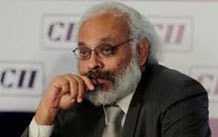1st Suresh Tendulkar Memorial Lecture

1st Suresh Tendulkar Memorial Lecture
The first lecture in the series was presented by Mr.Subir V.Gokarn on the 8th of December 2014 held at the Symbiosis Vishwabhawan. Subir Vithal Gokarn was appointed as the Governor of RBI for a period of three years from 2009 to 2012 at the age of 49, being one of the youngest Deputy Governors in the 76 years history of the RBI. Dr. Gokarn has supervised the Monetary Policy Department, Department of Statistics and Information Management, Department of Economic Analysis and Policy, Credit Guarantee Corporation, Department of Communication and Deposit Insurance and also represented the Reserve Bank at the G-20 Deputies` forum. Prior to joining the Reserve Bank, Dr. Gokarn has served as the Chief Economist of Standard & Poor’s Asia-Pacific, based in New Delhi, Executive Director and Chief Economist of CRISIL, Chief Economist and Industrial Finance Corporation of India (IFCI), Chair in Industrial Development at the National Council of Applied Economic Research (NCAER), New Delhi (2000-2002) and Associate Professor at the Indira Gandhi Institute of Development Research (IGIDR), Mumbai (1991-2000).
Dr. Gokarn graduated from St. Xavier’s College, Mumbai, with a B.A. (Hons.) in Economics (1979) and from the Delhi School of Economics with an M.A. in Economics (1981). After a two-year stint with the Bureau of Industrial Costs and Prices, he went on to pursue a Ph.D. in Economics at Case Western Reserve University, USA, which was awarded to him in 1989 for his thesis work was on the impact of capital market liberalization on industrial performance in South Korea. As 1997, Fulbright Research Fellow, he had the privilege and opportunity to spend an academic year at the Economic Growth Centre at Yale University, USA. Industrial Economics, Monetary Economics, Corporate Finance have been Dr. Gokarn’s strengths. His academic research has straddled a number of areas, including industry, infrastructure and comparative studies of the East Asian economies, besides macroeconomics.
Dr. Gokarn has authored a number of published works and project reports, including two co-authored books on the East Asian growth process and a co-edited volume on the structure of Indian industry. He has also contributed a fortnightly column on current economic issues to the Business Standard for 13 years.
Dr. Gokarn’s discourse focused on strategies of poverty alleviation, elaborating upon the top-down and bottom-up approaches to countering this age old dilemma. Suresh Tendulkar’s pioneering contribution was his extensive work on poverty and estimation of people below poverty line (BPL). Professor Tendulkar headed the Tendulkar Committee, in charge with looking into the people living under poverty line in India, where he introduced the Tendulkar Methodology of estimation of poverty.
Dr. Gokarn commenced his disquisition by analyzing the state of poverty and development in India, and the progress achieved over the last two decades. The poverty ratio saw a sharp decline during the high growth phase that the nation underwent over the last decade; the absolute number of poor having reduced for the first time, contrary to the trend.
The overall record on the wider Millennium Development Goals, while mixed, is certainly not bad. However, there are certain areas where there has been a lack of development in areas such as gender quality and maternal mortality rates. He also questioned the lack of concurrent improvements in sanitation and reducing hunger that should have resulted from reducing poverty and improved access to water.
The former deputy governor proceeded to elucidate the top-down approach citing a sample of growth rates and poverty rates of developing countries. He expounded that the impact of growth on poverty is not guaranteed. Rather, it is a long haul relationship and during the short run, a correlation between the two is weak. Low, but sustained, growth over a long period is more effective than high growth over a short period. Dr. Gokarn advocates a structural change in the economy: from the primary sector to secondary and tertiary, informal sector to formal; identifying several factors crucial to this transformation: investment in labour-intensive sectors, skill enhancement, making Small and Medium Enterprises (SMEs) more competitive. But the most important, by far, is infrastructure. These are all links in a chain, each subject to policy and risks of synchronization. However when these links are in place, the social dividends that are reaped are exponential.
Using the popular board game Chutes (read Snakes) and Ladders as a metaphor for the bottom-up approach, Dr. Gokarn defines Ladders as opportunities and Chutes as risks or uncertainties. The aim is to maximize the Ladders and minimize the Chutes.
Opportunities can only be effective through enablement, in early stages: nutrition, health care, education; and as an ongoing process: information and mobility. The other side of the same coin is provision of social protection. Countries that have lacked strong growth still show large declines in poverty due to such a safety net. Conditional Cash Transfers, or CCTs, in various forms are core to the success of social protection. They offer easily monitorable conditions as well as broad coverage.
These are good short term measures, but are unable to sustain poverty alleviation by themselves. Cash does not always work where markets do not exist. Reverting to the metaphor he used earlier, Dr. Gokarn stated that blocking of Chutes, and a creation of Ladders, needs to occur simultaneously.
Dr. Gokarn concluded the lecture by reiterating that growth does not, in fact, guarantee poverty reduction and that safety nets are only effective when embedded in a wider enablement framework.


